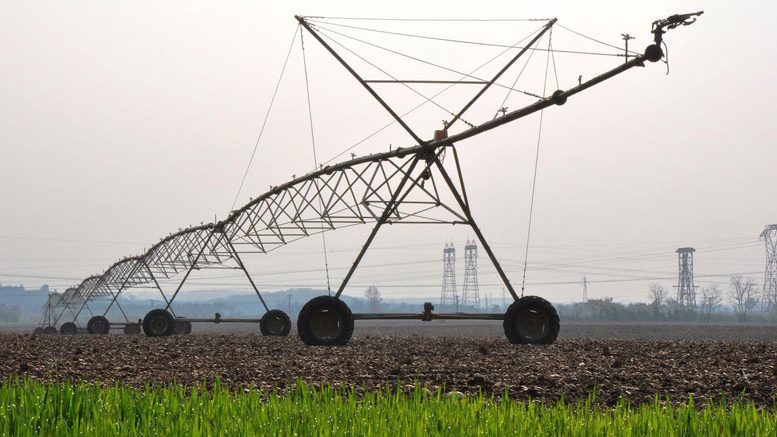|
Click to listen to this article
|
By Ali Montazar, Irrigation and Water Management Advisor, University of California Cooperative Extension
Climate-Smart Agriculture (CSA) is a catchy term that seems to imply farming smarter in an era of climate change, targeting increased productivity, enhanced resiliency and reduced emissions. More efficient water usage through drip and subsurface drip irrigation systems, supplemental and precision irrigation strategies and on-farm water conservation practices are considered as effective CSA tools to improve resource use efficiency.
The University of California recently conducted a viability assessment on utilizing subsurface drip irrigation (SDI) in the desert processed onions production system.
Processed onions are produced throughout California with nearly 8,800 acres of processed onion production in Imperial County.
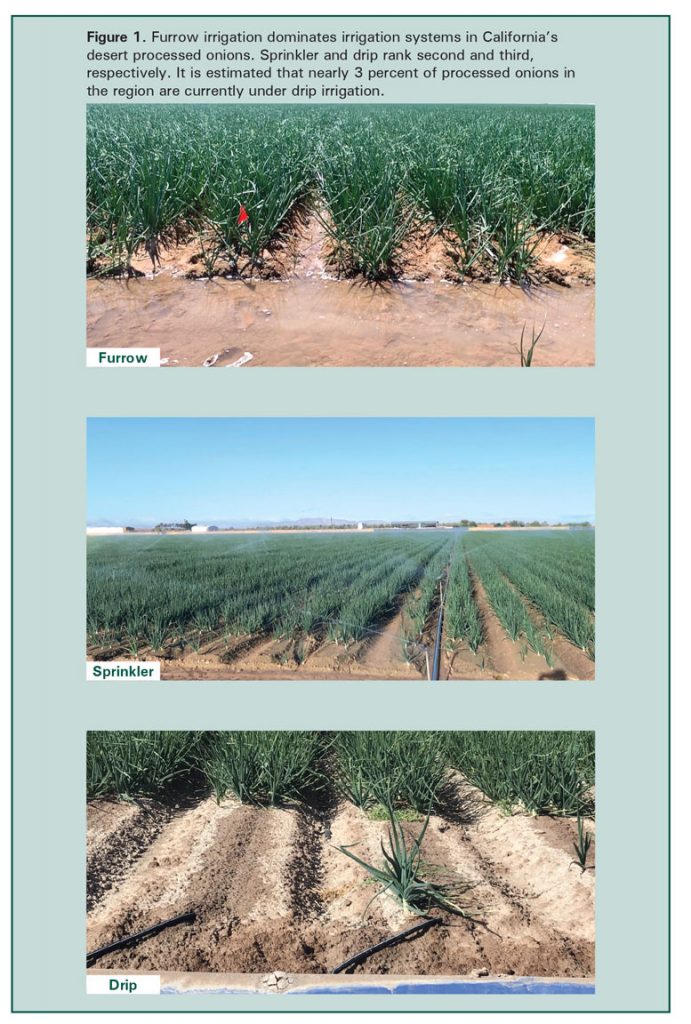
Field Trials
The experiment was carried out in six commercial fields in the Imperial Valley over two crop seasons (2019-20 and 2020-21). Of the six fields, two fields were drip irrigated, two were under sprinklers and the final two under furrow irrigation (Fig. 1). The drip-irrigated fields were established using drip, while the other four fields were germinated using sprinklers. All fields were on a 40-inch bed with six plant rows per bed and 2.5 inches between planting lines. The driplines were installed in the center of beds at an average depth of 1.5 inches.
Consumptive Water Use
The actual crop water use (actual crop evapotranspiration or actual ET) was measured using the residual of energy balance method with a combination of surface renewal and eddy covariance equipment.
Variable water consumptive use was observed over the crop seasons ranging from 0.02 in/day (Dec. 7, 2020) to 0.25 in/day (April 8, 2021) at the drip-irrigated field in the 2020-21 season (Fig. 2). The seasonal water consumptive use was 27.4 inches at this field with a long crop season of 237-day planting on Oct. 23, 2020. The cumulative onion crop water use of the drip-irrigated field was 26.2 inches in the 2019-20 season with a shorter crop season of 212-day planting on Nov. 8, 2019. This amount was, on average, 9 percent more at the sprinkler-irrigated fields than the drip-irrigated fields.
The results indicate that the seasonal crop water use may vary due to irrigation management and farming practices, soil type and conditions, and the length of crop season.
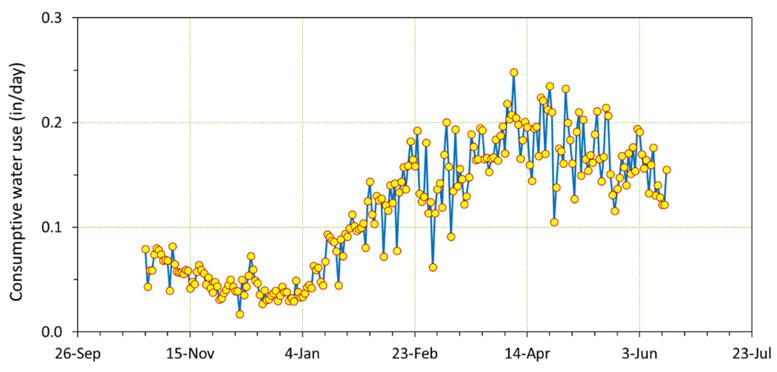
More Soil Moisture Uniformity
Onions require frequent irrigation throughout the crop season since the plant root system is shallow and very little water is extracted from soil depth of more than 2 feet. Most of the crop water needed is extracted from the topsoil (12 inches). In addition, onion roots are mostly non- adventitious (branching), and all roots originate at the stem or basal plate of the plant. Keeping the upper soil areas moist is required to stimulate healthy onion root growth.
Onions have low capacity for reducing their leaf water potential by osmotic adjustment to compensate for less water availability at the root, whether caused by dry soil or salinity issues.
The amount and frequency of irrigation water depends on the irrigation practice, soil type and conditions, and temperature. For optimal plant growth, it is recommended to irrigate onion fields when 25 percent of the available water in the top 2 feet of soil is depleted.
The key advantage of SDI systems is to apply irrigation water more frequently and uniformly across onion fields over the season. Since irrigation events can be scheduled more frequently, soil moisture may be maintained at a desired level, and consequently, the deep percolation is minimized the entire irrigation season (Fig. 3).

Considerable Water Conservation
Using solid-set sprinkler systems fortheprocessed onion stand establishment is a common practice in the low desert; however, the drip-irrigated fields in this study were germinated using drip.
Meaningful differences were observed between the seasonal applied water of the furrow-irrigated fields and both the drip- and sprinkler-irirgated fields (Fig. 4). Even though the length of crop season was different in these fields, it appears that the amount of water applied during a 178-day period after the first irrigation (the furrow-irrigated field was harvested 178 days after first irrigation) would be a good measure to compare water applied at these fields.
All three fields were planted between Oct. 13 and Oct. 22, 2020. The applied water during the 178-day period was 4.9, 2.8 and 2.7 ac-ft/ac for the furrow-, sprinkler- and drip-irrigated fields, respectively. At this period, 2.2 ac-ft/ac water was conserved at the drip-irrigated field compared to the furrow-irrigated field. The seasonal applied water was 3.3 and 3.5 ac-ft/ac at the drip- and sprinkler-irrigated fields.
Lower Costs for Downy Mildew Management
Downy mildew has complex environmental requirements, needing both cool temperatures and high humidity. Downy mildew spores are airborne and after landing on healthy plants, they require leaf wetness for infection to occur. Minimizing canopy leaf wetness could reduce the incidence and severity of downy mildew in onions. Lower disease pressure is generally expected in drip-irrigated fields due to less leaf wetness potential.
Growers apply different amounts and types of fungicides to control downy mildew depending on severity of disease in onion fields. While the total cost of fungicides applied per acre by growers is not a scientific measure to evaluate the impact of irrigation practices on downy mildew incidence, this indicator could be considred as an applied evaluation measure from a grower prespective. Growers generally apply more fungicides if the severity or the risk of disease is greater.
The data provided by the cooperative growers in the 2020-21 season demonstrated that the total cost of fungicides applied per acre for the drip-irrigated field was 96.2 percent less than the sprinkler-irrigated field and 54.6 percent less than the furrow-irrigated fields. The fields were nearly 2 miles away from each other, and it is assumed they experienced similar weather conditions.
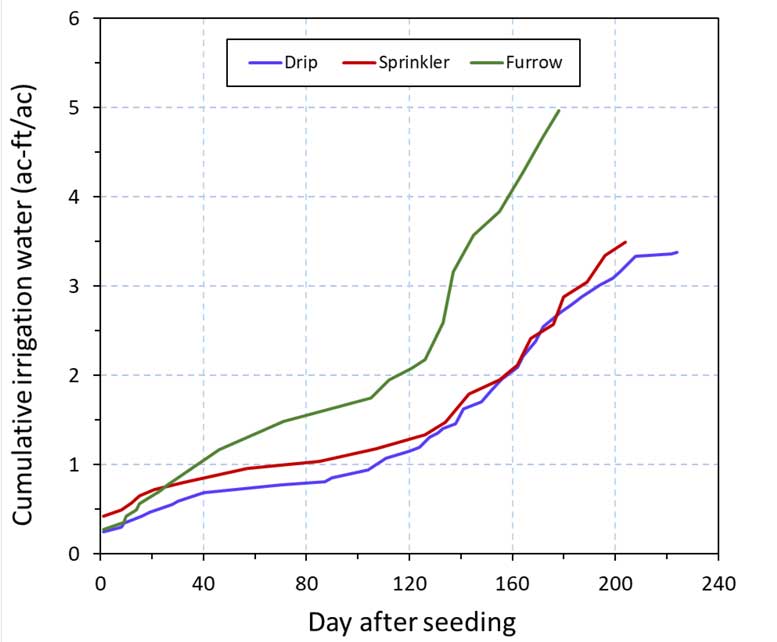
Greater Nitrogen-Use Efficiency
The total nitrogen accumulated in onion bulbs was determined at the experimental fields, and the total nitrogen applied quantities were monitored over the crop seasons. The nitrogen-use effiency measure was computed for each of the experimental fields as the ratio of nitrogen accumulated in onion bulbs to nitrogen units applied. The value of this measure for each field is shown in Fig. 5.
The results demonstrated that the mean nitrogen-use efficiency was greater at the drip-irrigated field (74.1 percent) than both sprinkler- (68.7 percent) and furrow- (45.7 percent) irrigated fields.
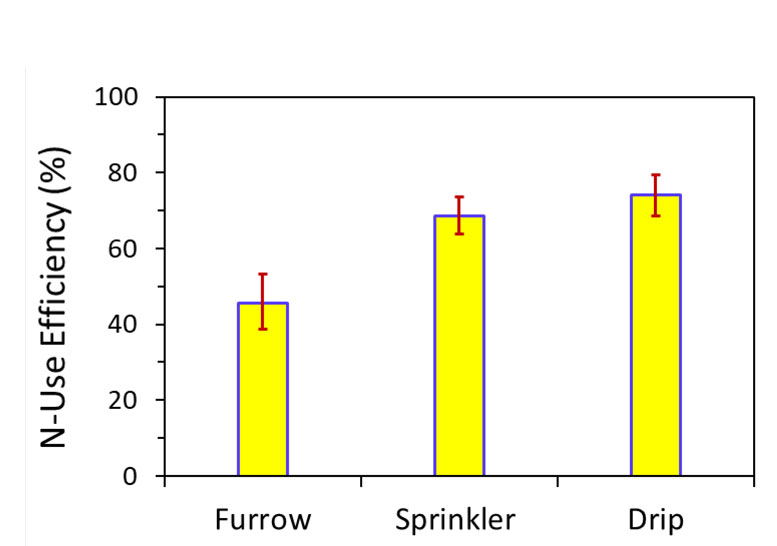
Higher Potential Yield
Different factors may affect the yields of processed onion fields, such as water and nutrient managemant practices, soil types and conditions, plant population and uniformity, length of crop season, and pest pressure and management. Therefore, a more comprehensive data set and analysis is required to assess the impact of irrigation methods on processed onion production in commercial fields.
The observations of this study illustrated that the average weight of onion bulbs per acre (at harvest) at the drip-irrigated field was nearly 21 percent and 4 percent greater than the furrow- and sprinkler-irrigated fields, respectively.
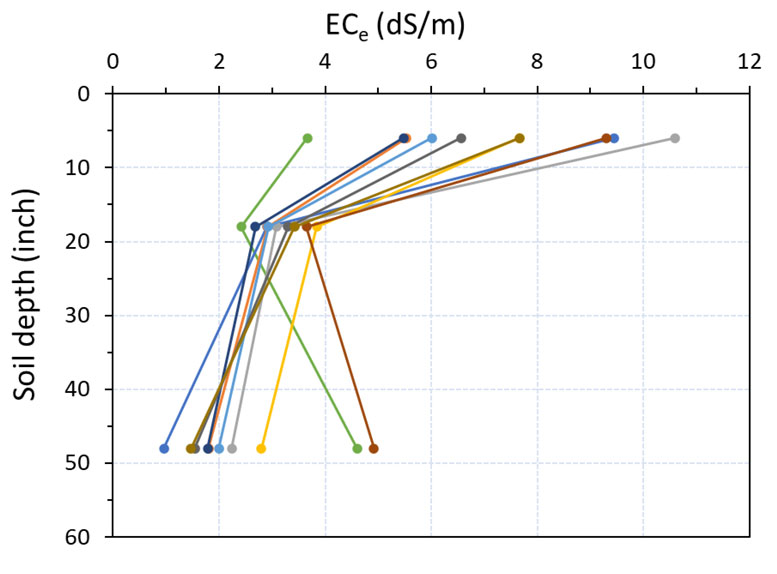
More Salt Accumulation on Topsoil
Salinity may decrease bulb diameter, bulb weight, root growth, plant height and number of leaves per plant in onions. Salinity often affects the timing of development, and flowering in onions occurs earlier under salt stress.
A salinity survey was conducted at each of the experimental sites which demonstrated salt accumulation on the topsoil at the drip-irrigated fields (Fig. 6). The survey showed that soil electrical conductivity (ECe) varied from 3.6 to 10.6 dS/m at the depth of 0-6 inches. The average ECe values at the same depth were lower at the furrow- and sprinkler-irrigated fields.
Buildup of soil saline conditions could occur on the topsoil in drip-irrigated processed onion fields. To maintain salinity over the season, applying sufficient irrigation water at high enough frequencies to guarantee adequate leaching in the effective crop root zone is required.
The salinty survey conducted after the summer leaching practice undertaken at this drip-irrigated field indicated that the entire soil profile was effectively leached and the high ECe values of the topsoil declined to an average of 1.8 dS/m in late September 2021. It is concluded that the current salt leaching practices in the region along with an effective drainage system can remove salt from the crop root zone and sustain soil producivity. Effective irrigation managmant of drip-irrigated fields may also maintain potential saline conditions of the topsoil over the season.
Author’s note: Funding for this study was provided by the California Garlic and Onion Research Advisory Board and the Imperial County Agricultural Benefits Program. I gratefully acknowledge the farms that contributed to this effort with sincere collaboration during the study and for allowing the research staff to implement the project in their agricultural operations.

